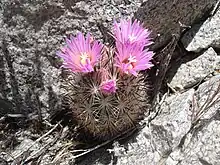| Pelecyphora alversonii | |
|---|---|
 | |
| Scientific classification | |
| Kingdom: | Plantae |
| Clade: | Tracheophytes |
| Clade: | Angiosperms |
| Clade: | Eudicots |
| Order: | Caryophyllales |
| Family: | Cactaceae |
| Subfamily: | Cactoideae |
| Genus: | Pelecyphora |
| Species: | P. alversonii |
| Binomial name | |
| Pelecyphora alversonii (J.M.Coult.) D.Aquino & Dan.Sánchez | |
| Synonyms | |
| |
Pelecyphora alversonii commonly known as cushion foxtail cactus or cushion fox-tail cactus, is a species of flowering plant in the family Cactaceae, native to the southwestern United States.[2]
Description
Pelecyphora alversonii usually grows sprouting and forms underground, cylindrical offshoots with a diameter of 6-9 cm. The more or less spherical shoots reach heights of up to 7-25 centimeters. The plants have 18-33 radial spines per areoles. The eight to ten central spines have a white to dark red or black tip and are 1.2 to 1.6 centimeters long. The twelve to 18 white marginal spines are 1.2 to 2 centimeters long.[3]
The flowers are magenta to pink and reach a diameter of around 3.2 centimeters. The ellipsoid fruits are green.[4] Chromosome count is 2n = 22.[5]
 P. alversonii in Joshua Tree National Park, California
P. alversonii in Joshua Tree National Park, California
Distribution
Pelecyphora alversonii is widespread in the United States in southeastern California in the Mojave Desert and neighboring Arizona at elevations around 75-600 meters.[5]
Taxonomy
The first description as Cactus radiosus var. alversonii by John Merle Coulter was published in 1894.[6] The specific epithet alversonii honors the mineral explorer Andrew H. Alverson (1845–1916). Nigel Paul Taylor placed the variety as a species in the genus Escobaria in 1997.[7] David Aquino & Daniel Sánchez moved the species to Pelecyphora based on phylogenetic studies in 2022.[8] Further nomenclature synonyms are Mammillaria alversonii (J.M.Coult.) Zeiss. (1895), Mammillaria radiosa var. alversonii (J.M.Coult.) K.Schum. (1898), Mammillaria arizonica var. alversonii (J.M.Coult.) Davidson & Moxley (1923), Coryphantha alversonii (J.M.Coult.) Orcutt (1926), Mammillaria vivipara var vivipara var. alversonii (J.M.Coult.) L.D.Benson (1969), Escobaria vivipara var. alversonii (J.M.Coult.) D.R.Hunt (1978) and Escobaria alversonii (J.M.Coult.) N.P.Taylor (1997).
References
- ↑ "The IUCN Red List of Threatened Species". IUCN Red List of Threatened Species. 2010-05-11. Retrieved 2023-11-23.
- ↑ "Pelecyphora alversonii (J.M.Coult.) D.Aquino & Dan.Sánchez". Plants of the World Online. Retrieved 2023-11-23.
- ↑ The American Southwest (2014-05-02). "Escobaria alversonii, Cushion foxtail cactus". National Parks and National Monuments of the American Southwest and West. Retrieved 2023-11-24.
- ↑ Anderson, Edward F.; Eggli, Urs (2005). Das grosse Kakteen-Lexikon (in German). Stuttgart (Hohenheim): Ulmer. p. 272. ISBN 3-8001-4573-1.
- 1 2 "Coryphantha alversonii". University and Jepson Herbaria Home Page. 2023-11-24. Retrieved 2023-11-24.
- ↑ Ewan, Joseph (1963). "ANDREW ALVERSON (1845-1916) OF CALIFORNIA AND HISCACTUS CATALOGUE". Journal of the Society for the Bibliography of Natural History. Edinburgh University Press. 4 (3): 170–177. doi:10.3366/jsbnh.1963.4.3.170. ISSN 0037-9778.
- ↑ States., United (1892). "Contributions from the United States National Herbarium". Smithsonian Institution Press. Retrieved 2023-11-24.
- ↑ Sánchez, Daniel; Vázquez-Benítez, Balbina; Vázquez-Sánchez, Monserrat; Aquino, David; Arias, Salvador (2022-01-21). "Phylogenetic relationships in Coryphantha and implications on Pelecyphora and Escobaria (Cacteae, Cactoideae, Cactaceae)". PhytoKeys. Pensoft Publishers. 188: 115–165. doi:10.3897/phytokeys.188.75739. ISSN 1314-2003.
External links
 Media related to Pelecyphora alversonii at Wikimedia Commons
Media related to Pelecyphora alversonii at Wikimedia Commons Data related to Pelecyphora alversonii at Wikispecies
Data related to Pelecyphora alversonii at Wikispecies
